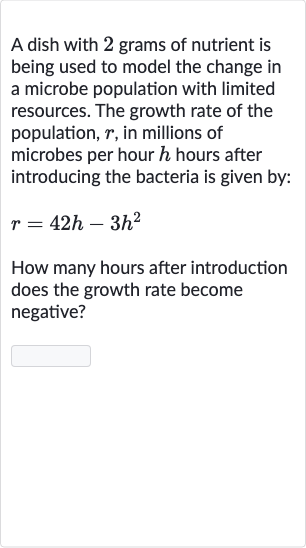AI tutor
Welcome to Bytelearn!
Let’s check out your problem:

A dish with grams of nutrient is being used to model the change in a microbe population with limited resources. The growth rate of the population, , in millions of microbes per hour hours after introducing the bacteria is given by:How many hours after introduction does the growth rate become negative?
Full solution
Q. A dish with grams of nutrient is being used to model the change in a microbe population with limited resources. The growth rate of the population, , in millions of microbes per hour hours after introducing the bacteria is given by:How many hours after introduction does the growth rate become negative?
- Write Growth Rate Equation: Write down the given growth rate equation.The growth rate of the microbe population is given by the equation:
- Determine Negative Growth Rate: Determine when the growth rate becomes negative.For the growth rate to become negative, must be less than . So we need to find the value of for which:42h - 3h^2 < 0
- Factor Quadratic Inequality: Factor the quadratic inequality.To solve the inequality, we can factor out :h(42 - 3h) < 0
- Find Critical Points: Find the critical points of the inequality.The critical points are the values of that make the expression equal to zero: or
- Solve for h: Solve for h when .
- Analyze Intervals: Analyze the intervals determined by the critical points.We have two intervals to consider: and . We need to determine which interval will result in a negative growth rate.
- Test Interval : Test a value from the interval in the original inequality.Let's test :Since is positive, the growth rate is not negative in this interval.
- Test Interval 14, \infty): Test a value from the interval \$14, \infty) in the original inequality.\(\newlineLet's test \$h = 15\):\(\newline\)\[r = 42(15) - 3(15)^2\]\(\newline\)\[r = 630 - 3(225)\]\(\newline\)\[r = 630 - 675\]\(\newline\)\[r = -45\]\(\newline\)Since \(r\) is negative, the growth rate becomes negative in this interval.
- Conclude Negative Growth Rate: Conclude the number of hours after which the growth rate becomes negative. The growth rate becomes negative after \(h = 14\) hours.
